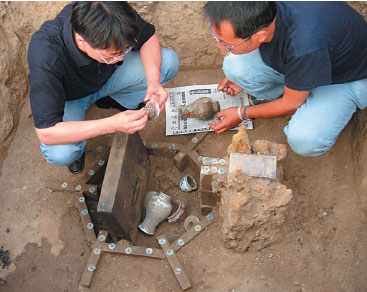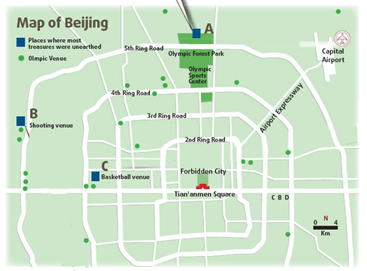
Two archaeologists work on a tomb nearby the Olympic Forest Park with special arrangment that represents a turtle.The six bricks that strech out of the hexagon pit are the head,tail and four feet of a turtle, its tail pointing to the north.[China Daily]

|
When the world's top athletes gather at the 31 newly-built arenas for the Beijing Olympics to compete for gold, silver and bronze, many might not realize that right beneath where they stand were buried mounds of "gold, silver and bronze" treasures, some dating back 2,000 years.

A: Five-color Porcelain Jar.
B: Jade Belt;Crane-and-cloud pot; Gold Gawu
C: Jade Fish;Terra-cotta Jar;Terra-cotta pot.
|
Archaeologists surveyed about 1.6 million square meters of land at about 17 under-construction Olympic venues between April 2004 and last November, and unearthed 700 ancient tombs with 1,500 artifacts, according to Kong Fanzhi, head of Beijing Administration of Cultural Heritage.
Fittingly, Kong's briefing was held at the reconstruction sites of two ancient temples, one next to the National Aquatics Center and the other near the neighboring Olympic Village.
"Beijing has inherited a rich collection of cultural relics, so the construction of Olympic venues had to take their preservation into consideration. This is part of the government's promise to host a 'Cultural Olympics'".
As most of the city's relics rest inside Beijing's ancient city walls - a fortification built around 1435 in the Ming Dynasty (1368-1644) and now replaced by the city's second ring road - and the city wall of the Yuan Dynasty (1279-1368), which is located a little north of the North Third Ring Road, none of the Olympic venues were built inside or nearby these relics-rich city walls.
The foundation of the Water Cube, the aquatics center, was laid 100 meters further north to its original chosen site so that a nearby 500-year-old Taoist temple dedicated to the fertility goddess, could survive.
Yet due to unavoidable construction at the chosen sites, Kong's team had to excavate 9,787 square meters of land, about 0.6 percent of the total area they surveyed. The artifacts unearthed from the mostly-civilian tombs will be used for research and displays.